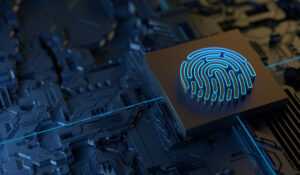
Biometric access control is the next step in creating a more secure facility that needs to limit access only to authorized individuals.
Traditional security measures like passwords and keycards aren’t always sufficient when it comes to facility security. Biometric access control has emerged as a cutting-edge solution, leveraging unique physiological and behavioral characteristics for identity verification. Let’s talk about what biometric access control is, explore its various types, discuss how it enhances facility security, and highlight the industries that currently benefit from its implementation.
What is Biometric Access Control?
Biometric access control is a security system that uses biological data to authenticate and grant access to individuals. Unlike traditional methods that rely on something a person knows (password) or something a person has (keycard), biometric systems verify authorization based on a person’s inherent physical characteristics. This authentication method is grounded in the uniqueness of individual biometric traits, making it significantly harder to forge or steal.
Types of Biometric Systems
Biometric access control systems utilize various physiological and behavioral characteristics. Here are the most common types:
- Fingerprint Recognition: This is one of the oldest and most widely used biometric methods. It scans the unique patterns of ridges and valleys on a person’s finger.
- Facial Recognition: This system maps an individual’s facial features and compares them with stored data. It analyzes aspects like the distance between eyes, nose width, and jawline shape.
- Iris Recognition: Iris recognition systems scan the unique patterns in the colored ring of the eye. It’s highly accurate due to the complexity and uniqueness of the iris.
- Retina Scanning: This method involves analyzing the unique pattern of blood vessels in the retina. It’s extremely secure but can be invasive and uncomfortable for users.
- Voice Recognition: Voice recognition systems analyze the unique characteristics of a person’s voice, including pitch, tone, and cadence.
- Palm Vein Recognition: This technology scans the unique pattern of veins in a person’s palm using infrared light, offering high accuracy and security.
- Hand Geometry: This method measures and records the shape and size of an individual’s hand. Though less unique than fingerprints or irises, it is still a useful biometric trait.
Enhancing Facility Security
Biometric systems provide a higher level of security compared to traditional methods for several reasons:
- Accuracy and Reliability: Biometrics are inherently unique to each individual, reducing the risk of unauthorized access. The chances of two individuals having the same biometric data are virtually nonexistent.
- Convenience: Users do not need to remember passwords or carry access cards, which can be lost or stolen. Authentication is quick and seamless.
- Audit Trail: Biometric systems often log access attempts, creating an audit trail that helps in tracking entries and exits, thereby enhancing security monitoring.
- Scalability: Biometric systems can be scaled easily across large facilities, ensuring consistent security measures are in place.
- Integration with Other Systems: Biometric access control can be integrated with other security systems, such as CCTV, alarms, and IT security systems, creating a comprehensive security solution.
Industries Leveraging Biometric Access Control
Various industries have adopted biometric access control to enhance security:
- Finance: Banks and financial institutions use biometric systems to secure vaults, data centers, and even ATMs, protecting against unauthorized access and fraud.
- Healthcare: Hospitals and clinics use biometric access to secure patient records, restrict access to certain areas, and ensure that only authorized personnel can access sensitive medical equipment and medications.
- Government and Defense: Biometric systems are essential in government buildings and military installations to protect classified information and ensure that only authorized personnel have access to sensitive areas.
- Airports and Transportation: Airports use biometric access systems to enhance passenger security and streamline boarding processes. It is also used for securing restricted areas within transportation hubs.
- Education: Universities and research institutions use biometric systems to secure labs, libraries, and dormitories, ensuring the safety of students and staff.
- Corporate Offices: Companies use biometric access control to secure their premises, protect intellectual property, and ensure only authorized employees can access certain areas.
- Hospitality: Hotels use biometrics for secure room access and to enhance the overall security and experience of their guests.
TRUST THE PROFESSIONALS AT ARK SYSTEMS
Located in Columbia, Maryland, ARK Systems provides unsurpassed quality and excellence in the security industry, from system design all the way through to installation. We handle all aspects of security with local and remote locations. With over 30 years in the industry, ARK Systems is an experienced security contractor. Trust ARK to handle your most sensitive data storage, surveillance, and security solutions.
Contact ARK Systems at 1-800-995-0189 or click here today. Check us out on Facebook and Twitter as well!
This entry was posted on Thursday, June 20th, 2024 at 2:16 pm. Both comments and pings are currently closed.